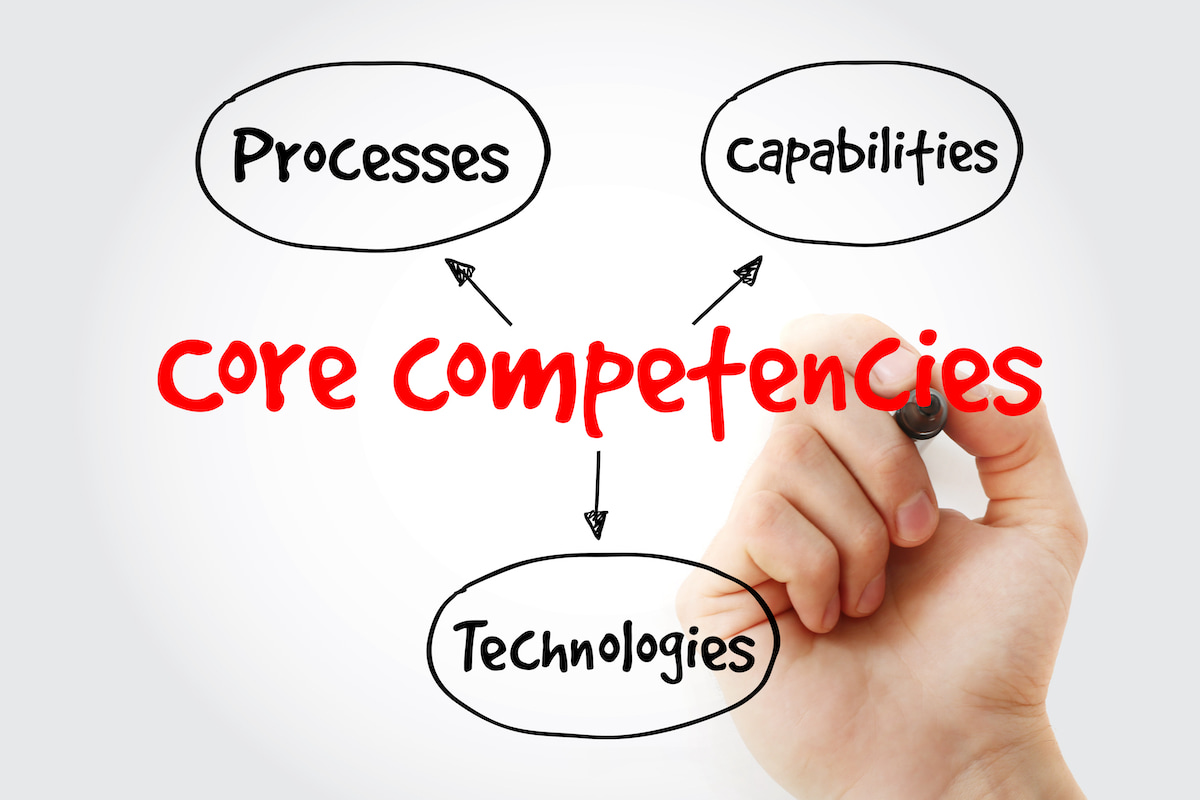Have you ever drilled down into the unique abilities of your business? Or picked something that you know you can compete on? There’s likely to be a set of skills and experience within your business that sits above products and services and delivers you a competitive advantage.
These features are the essence of your business’s core competencies, and identifying them will help your business gain strategic advantages, provide superior products and services and ultimately achieve the growth you crave.
When we start a two-day, strategic kick-off with Executive teams, we ask everyone to write down what they think their organisation’s core competency is. It’s fascinating. Every answer is different, and it’s difficult to find a consensus. It shows up very quickly the lack of consistency around what they’re trying to do.
It’s vital to define and get agreement on the capabilities and organisation-wide strengths that help your business stay ahead. This collective learning around your competitive advantages and the superior value you offer your customers are the hallmarks of a successful business.
What are a company’s core competencies?

Core competencies matter; they are the engine for the development of core products and services. Prahalad and Hamel described core competencies as ‘the roots out of which businesses grow, like a tree whose fruit is the end product.’
Types of core competencies
There are a number of different types of company’s core competencies. They tend to fall under the following headings:
– Quality.
This could be the quality of a product or service. Quality customer service was our core competence at Rackspace. In fact, we were fanatical about it. It was in our DNA and became our obsession. We knew this was how we were going to compete. It guided every strategic decision we made. Hiring, firing, onboarding, acquisitions – everything was consistent with our core competency of quality. Quality control could also have been a strong contender as a core competencies capabilities at Rackspace.
– Value.
When you obsess about value, it doesn’t mean that quality isn’t important. But it isn’t your vector for competitive advantage. If value is one of your core competencies, then quality needs to be good enough, but no better than this.
Real-world examples of businesses with value among their core competencies are Mcdonald’s and Southwest Airlines. Both maintain a consistent level of quality, but they’ve realised that to compete in their market, they need to be perceived as a value buy. So in the case of Southwest Airlines, there are no meals, no pre-paid seating and no business class, but they’re reliable and low-cost.
– Innovation.
You’ve got organisations like 3M that are innovation machines – it’s their business to innovate, and they do it brilliantly. Accenture is very acquisitive and constantly brings new services into its business. This is a way of innovating products or services by buying them in. Car manufacturers also have this as a core competency as they are constantly innovating and developing new models.
How do you work out your core competencies?
Identifying core competencies isn’t just about recognising what you excel at; it’s about understanding what sets your business apart in a crowded marketplace. These are the unique strengths ingrained in the DNA of your organisation that allow you to deliver value to your customers. It’s the intersection of what you do best and what your customers value most. By narrowing in on these core competencies, you ensure that your business isn’t just operating but thriving, evolving, and staying ahead of the competition. This deep introspection is more than an exercise—it’s the foundation of your future strategic decisions and your competitive advantage.
This is all about focus. You need to isolate the core capabilities of your organisation and hone them into your organisational strengths. Something that can be helpful here, which we use with our clients, is an Activity Fit Map.
This diagnostic tool will help identify your company’s competitive advantage and, implicit in this, your core competencies. Crucially, any competency needs to be supported by every function in the business – hence the name, ‘Activity Fit.
Here’s an illustration. We had a client with us recently who told us that their people strategy was one of their core competencies. But when we did their activity fit map, there were no HR activities that were unique in their business. Therefore, HR was making no contribution at all to any core competencies. It was unlikely that the quality of their people was one of their core competencies, as there was no way to measure this.
You can’t just say, ‘We’ve got better people’. There needs to be a metric. If, let’s say, they were measuring the length of service; perhaps this might have driven higher customer satisfaction and higher revenue. They had no evidence of this, though.
It might be that you believe your team has distinctive competencies and higher levels of accreditations than your competitors, and your hypothesis is that this might lead to greater trust in your brand and improved consumer delight. Yes, your people are more expensive due to their higher levels of software certification. But this might mean you’re able to deliver projects faster as your people have better skills. There could be one of your core competencies right there.
One of our clients, NearForm, feels their team is more like the SAS than the infantry. There are fewer of them, but their projects move faster.

Look through a customer lens when understanding core competencies
Switching gears to view your business through a customer lens can be transformative. It’s not just about what you believe you’re excellent at but more about what your customers perceive as your unique value. Engage directly, asking them why they chose you over competitors and where they see you excel. Dive into their journey with your brand – from awareness to post-sale support – and unearth those moments that turn them from mere customers to loyal promoters. When you combine their feedback with your internal view, you uncover core competencies that resonate at an impactful level. In essence, to truly grasp your core competencies, you must immerse yourself in the customer experience, listening intently and aligning your business strategies with the unique value they perceive you deliver.
Always look through a customer lens when you identify core competencies. This needs to be about differentiation in your marketplace. Whatever you decide is your core competency should improve your willingness to pay drivers or reduce your cost drivers. If it doesn’t do this, then it’s not making any contribution to net profit or your differentiation in the market. Try to avoid the trap of looking through an internal company lens.
Your core competency can impact alliances and acquisitions as well as licensing arrangements. This is because it gives you a lens through which to look at the competitive landscape and decide who you should work with and who you shouldn’t. All the time, you should be looking to build on your organisation’s strengths in particular core areas.
Guiding strategic decisions
Knowing your core competencies may also lead you to outsource or divest non-core capabilities. In fact, it makes these strategic decisions much easier.
During my time leading Rackspace UK, there was a part of the business called ServerBeach. We launched this to counter the threat of a competitor who was offering cheaper Linux hosting. ServerBeach had cheaper hardware and data centres and offered little support. And that made it out of profile with Rackspace’s core competency of service quality.
The management team felt they were having to state shift constantly. One minute they were running Rackspace and obsessing about fanatical support, and the next, ServerBeach with no support. So we decided to sell this part of the business to Peer 1 Hosting. It was a no-brainer!
The three tests for a core competency
So how do you know if you’ve identified core competencies? Put them through three tests:
– Do they lead to a new product or service development in multiple markets?
– Do they make a significant contribution to the perceived benefits of a core product?
– Are they difficult for your competitors to imitate?
If you’ve answered yes to all three of these, then congratulations. You’ve defined your core competencies! Remember, you’re looking for your organisation’s core strategic strengths here.
So why use core competencies?
Embracing core competencies is a powerful lever to propel a business forward. Once identified, these competencies become your north star, guiding your strategic decisions. First, they shape product and service innovation, ensuring you consistently deliver unique value. They also inform hiring decisions, attracting talent that aligns with and enhances your business strengths. In marketing and branding efforts, core competencies distinguish your business in a commoditised marketplace, telling a compelling story that resonates with ICPs (ideal customer profile). They can pave the way for potential collaborations and partnerships, identifying areas where complementing external expertise can bolster your offering. In essence, core competencies are not static badges of honour but dynamic tools that, when leveraged wisely, steer a business towards sustainable growth and success.
Core competencies will help you decide which direction to go in as a business. They will also unify the company across business and functional units. These are the things that are consistently true about your business, differentiating you from your competition. They’ll also help employees understand the priorities of business managers.

